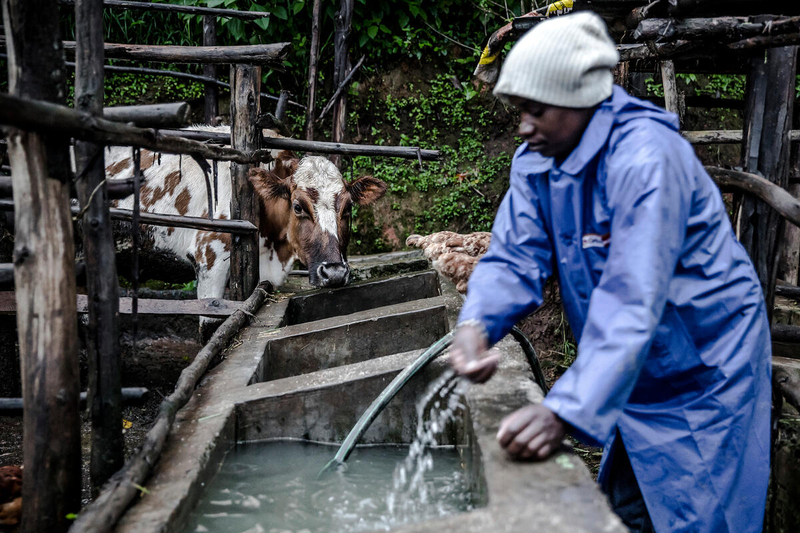New climate programme channels investment to transform East Africa’s dairy sector

Nicholson Mulwa prepares clean water and feed for his cows at his farm in Machakos, Machakos County, Kenya.
©FAO/Luis Tato
A major new climate action programme – Dairy Interventions for Mitigation and Adaptation (DaIMA) – is set to advance the dairy sector in Kenya, Rwanda, Tanzania and Uganda.
Approved this week by the Green Climate Fund (GCF) Board, with programme design prepared by the International Fund for Agricultural Development (IFAD) in collaboration with the FAO Investment Centre and the governments of Kenya, Rwanda, Tanzania and Uganda, DaIMA aims to reduce emissions and make dairy systems more productive and resilient, directly benefiting 2.5 million people.
With a total investment of USD 358.26 million, DaIMA represents several firsts: it is the first livestock project approved by the GCF, and the first to emerge from a joint initiative of GCF, IFAD, FAO and the Global Dairy Platform launched at COP27, to support the development of public-private programmes to reduce livestock sector greenhouse gas (GHG) emissions.
DaIMA will support smallholder producers in East Africa to adopt low-emission, climate-smart practices, enhance rangeland and manure management, cut milk losses and enhance productivity. It will facilitate investment in circular business models such as biogas and organic fertiliser production, while promoting green value chains and improved access to safe, nutritious milk. A new Green Dairy Financing Facility will mobilize climate finance through national development banks and expand access to capital for private climate-resilient dairy enterprises.
The programme also aims to strengthen national dairy policies, climate services and measurement, GHG reporting mechanisms, creating enabling conditions for long-term GHG emissions reduction and productivity gains in the dairy sector.
“This is a truly transformative moment for East Africa’s dairy sector,” said Julien Vallet, Economist with FAO’s Investment Centre and DaIMA’s technical team lead at FAO. “The approval of DaIMA enables large-scale deployment of low-emission solutions in the dairy sector – from production efficiency and circularity to pasture restoration and improved measurement, reporting, and verification systems – all aligned with national climate goals.”
The programme will be one of the first to apply FAO’s GLEAM-i (Global Livestock Environmental Assessment Model – interactive) during implementation to model and track emissions across national dairy systems – enabling robust GHG accounting and mitigation projections.
“IFAD is committed to delivering 45 percent of its climate finance in the 2025–2027 cycle,” said Anne Mottet, Lead Technical Specialist (Livestock), Sustainable Production, Markets and Institutions Division, IFAD. “Partnerships like the one with FAO – and using tools like GLEAM-i – are essential to assess and report the impact of our climate investments in livestock systems.”
Over two years, IFAD, with FAO Investment Centre support, worked together with national governments, technical partners and civil society to co-design the programme.
As part of the process, FAO's Animal Production and Health Division helped to carry out emissions analysis from the dairy sector. FAO’s Office of Climate Change, Biodiversity and Environment conducted climate risk assessments, including modelling the impacts of heat stress and humidity on dairy productivity. The Renewable Energy Team explored investment solutions to decarbonize dairy operations through biogas and solar-powered cold chains.
Together, these assessments helped build a strong technical case for investment.
With expected outcomes including a 29 percent reduction in emission intensity, a 34 percent rise in milk production, and over 2.17 million tonnes of GHG emissions (CO2eq) avoided, DaIMA is set to play a key role in advancing both adaptation and mitigation goals – and is poised to serve as a model for climate-resilient, low-emission livestock systems investment.
